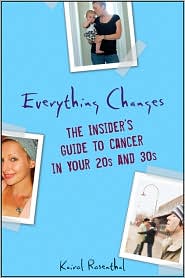The Ojays - For The Love of Money LIVE, 1974!! I remember hearing my dad play this O'Jays' classic as I grew up.
After posting Money Talks I, I received an excellent and detailed commentary from Everything Changes: The Guide to Young Adult Cancer in Your 20s and 30s author Kariol Rosenthal. (You can check out her blog and learn more about her book here.)


Kairol Rosenthal, author of Everything Changes: The Guide to Young Adult Cancer in Your 20s and 30s
This was very exciting for me because I love comments and plus it also comes from not just an established author, but an established Thr'yvor, cancer survivor author. I decided to do Money Talks II and post her commentary about the "Cancer diagnosis as a risk for bankruptcy" article. Kairol's commentary is worth a read and she also gives an American perspective on the topic. I have posted her comments below.
Kairol Rosenthal's Comments to my post Money Talks I
Great post. I’ve been mulling this over and have come up with a few hypotheses too. I wonder what you think:
1. Thyroid Cancer has a higher survival rate.
Thyroid cancer has overall survival rates much higher than most other cancers. (According to the National Cancer Institute, 10-year overall relative survival rates for patients in the United States are 93% for papillary cancer, 85% for follicular cancer, 75% for medullary cancer, and 14% for undifferentiated/anaplastic cancer.) Because we have much longer to live than patients with many other kinds of cancers, we have more time for bills to rack up and more time to go into debt and need to file for bankruptcy. For example, I have had the good fortune of racking up more medical bills for my thyroid cancer than my friend Erica, whose particular form of brain cancer had a 2% survival rate. She died less than two years after diagnosis, and ya can’t file for bankruptcy when you are dead.
2. Faster recovery times.
Most thyroid cancer patients are able to go back to work fairly soon after treatments such as surgery and radioactive iodine. (My recovery too way, way longer, but I know I’m not the norm.) Because many of us continue to work through out our disease course, I bet that lots of US citizens with thyroid cancer, who are still working and earning an income, don’t qualify for government assistance like Medicaid, or other financial relief based on income. So I wonder if it could be because we are more so often physically able to work as compared to other cancer patients that we don’t as often qualify for government assistance, have to pick up more of the costs ourselves, and therefore file for bankruptcy more often.
3. The Asian factor.
This study was limited to only the western half of one state in the United States. I think the study should be called ‘Cancer As Risk factor for Personal Bankruptcy in Western Washington State’. There might be so many factors that pertain to western Washington, and not to other geographic locations, that account for the thyroid cancer being the second highest rate of bankruptcy. For example, at 16%, the Asian population in the Seattle-Tacoma area is much, much larger than elsewhere in the United States. Being Asian is one of the top-five risk factors listed for getting thyroid cancer. Is a higher percentage of the thyroid cancer population in western Washington Asian? And if so, are there cultural factors that could impact why Asians would also have higher bankruptcy rates, such as higher rate of uninsured, or overall lower incomes? I don’t know the answers to these questions, but do wonder if issues like this contribute to the outcomes of the study showing thyroid cancer as the second highest cancer group to file for bankruptcy. I hope this study has garnered enough interest for it to be repeated in a way that accounts for geography and population factors.
4. Predisposition to bankruptcy prior to diagnosis.
It was interesting to see that although thyroid cancer was the second most often filed for bankruptcy, lung cancer was still DOUBLE that of thyroid cancer. The two highest risk factors for lung cancer are smoking and exposure to second hand smoke and to other caustic materials and elements like asbestos and nickel. Smoking rates are almost double among people living below the poverty level and exposure to caustic materials is also much higher among the poor. So it seems possible that poorer people have a higher chance of getting lung cancer. This is a factor that the study does not consider. And it makes me wonder if there could be similar factors that could predispose the population in western Washington to higher rates of both thyroid cancer and poverty.
Thanks again for giving me much to think about.
Kairol
July 2, 2011 2:25 PM
No comments:
Post a Comment